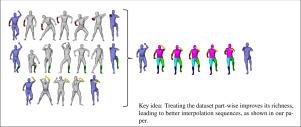Computer-Aided Design ( IF 4.3 ) Pub Date : 2021-03-15 , DOI: 10.1016/j.cad.2021.103027 Melike Aydınlılar , Yusuf Sahillioğlu

|
An active problem in digital geometry processing is shape interpolation which aims to generate a continuous sequence of in-betweens for a given source and target shape. Unlike traditional approaches that interpolate source and target shapes in isolation, recent data-driven approaches utilize multiple interpolations through intermediate database shapes, and consequently perform better at the expense of a database requirement. In contrast to the existing data-driven approaches that consider intermediate shapes as full inseparable entities, our novel data-driven method treats the shapes as separable parts. In particular, we interpolate parts over different intermediate shapes and merge them all in the end, which brings more flexibility and variety than the existing ways of interpolating the full shape as a whole over one fixed set of intermediates. To be able to proceed consistently over different sets of intermediate shapes, we construct a unified framework based on parametric curves. We justify the two key points in the proposed method, interpolating parts separately and data-driven by curve parameterization, in the qualitative and quantitative evaluations. We demonstrate promising results in comparison with five other techniques. Our method morphs not only poses but also forms, e.g., turning one person to another. The results are improved further with a mild data augmentation procedure that is based on the original algorithm. As a side contribution, we provide a public articulated hand dataset with fixed connectivity, which can be used in the evaluation of other interpolation methods.
中文翻译:

基于零件的数据驱动3D形状插值
数字几何处理中的一个活跃问题是形状插值,其目的是针对给定的源形状和目标形状生成一系列中间的连续序列。与传统的方法孤立地对源形状和目标形状进行插值的方法不同,最近的数据驱动方法通过中间数据库形状利用多个插值,因此以牺牲数据库需求为代价来实现更好的性能。与将中间形状视为完全不可分割的实体的现有数据驱动方法相反,我们新颖的数据驱动方法将形状视为可分离的部分。特别是,我们将零件插值到不同的中间形状上,然后将它们全部合并在一起,这比在一组固定的中间件上将整个形状整体插值的现有方式具有更大的灵活性和多样性。为了能够在不同的中间形状集上一致地进行,我们基于参数曲线构造了一个统一的框架。在定性和定量评估中,我们证明了所提出方法的两个关键点:分别插补零件和通过曲线参数化进行数据驱动。与其他五种技术相比,我们证明了令人鼓舞的结果。我们的方法不仅可以变形姿势,还可以变形,例如将一个人变成另一个人。基于原始算法的温和数据增强程序可进一步改善结果。作为附带的贡献,我们提供了具有固定连接性的公共铰接式手形数据集,可用于评估其他插值方法。我们基于参数曲线构建了一个统一的框架。在定性和定量评估中,我们证明了所提出方法的两个关键点:分别插补零件和通过曲线参数化进行数据驱动。与其他五种技术相比,我们证明了令人鼓舞的结果。我们的方法不仅可以变形姿势,还可以变形,例如将一个人变成另一个人。基于原始算法的温和数据增强程序可进一步改善结果。作为附带的贡献,我们提供了具有固定连接性的公共铰接式手形数据集,可用于评估其他插值方法。我们基于参数曲线构建了一个统一的框架。在定性和定量评估中,我们证明了所提出方法的两个关键点:分别插补零件和通过曲线参数化进行数据驱动。与其他五种技术相比,我们证明了令人鼓舞的结果。我们的方法不仅可以变形姿势,还可以变形,例如将一个人变成另一个人。基于原始算法的温和数据增强程序可进一步改善结果。作为附带的贡献,我们提供了具有固定连接性的公共铰接式手形数据集,可用于评估其他插值方法。在定性和定量评估中。与其他五种技术相比,我们证明了令人鼓舞的结果。我们的方法不仅可以变形姿势,还可以变形,例如将一个人变成另一个人。基于原始算法的温和数据增强程序可进一步改善结果。作为附带的贡献,我们提供了具有固定连接性的公共铰接式手形数据集,可用于评估其他插值方法。在定性和定量评估中。与其他五种技术相比,我们证明了令人鼓舞的结果。我们的方法不仅可以变形姿势,还可以变形,例如将一个人变成另一个人。基于原始算法的温和数据增强程序可进一步改善结果。作为附带的贡献,我们提供了具有固定连接性的公共铰接式手形数据集,可用于评估其他插值方法。


























 京公网安备 11010802027423号
京公网安备 11010802027423号